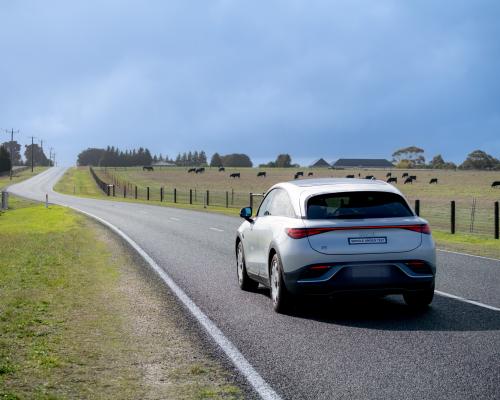
A government-funded program to test the true performance of vehicles has found the driving range of five popular electric cars is between 5% and 23% lower than results from laboratory testing.
The Australian Automobile Association tested vehicles from Tesla, BYD, Kia and Smart – the first EVs to be put through its four-year, federally funded Real World Testing Program to give consumers more accurate information on vehicle performance.
The extended range variant of the BYD Atto3 had the largest discrepancy, according to the AAA, with a real-world range of 369km, 23% lower than the 480km achieved in laboratory testing. The Smart #3 had the lowest, with only a 5% difference.
The Tesla Model 3 had a real-world range 14% lower than the lab test. Tesla’s Model Y and the Kia EV6 both had a real world range 8% lower.
Sign up: AU Breaking News email
Despite showing a gap between lab and real-world results, the AAA and electric vehicle industry representatives said the results should reduce range anxiety among consumers looking to buy an EV.
The Electric Vehicle Council industry body’s head of legal, policy and advocacy, Aman Gaur, said the AAA’s results should “give confidence that EVs have more than enough range for everyday Australians”.
“The average Australian drives 33km per day. This means that an EV with a range of 350km can be driven for more than 10 days before needing to be recharged,” he said.
The results come after the AAA released a summary last month of tests on 114 petrol, diesel and hybrid vehicles that showed 77% used more fuel than advertised. One in five also broke noxious emissions that were advertised from lab tests.
Carmakers advertise the results of government-mandated laboratory tests on emissions, fuel efficiency and, in the case of EVs, their energy consumption and range with a fully charged battery. The government’s Green Vehicle Guide lists the results for all vehicles.
AAA’s managing director, Michael Bradley, said the Real World Testing Program had found consumers couldn’t always rely on the laboratory tests as an indicator of real-world performance.
“As more EVs enter our market, our testing will help consumers understand which new market entrants measure up on battery range,” he said.
Vehicles tested in the AAA program are taken on a 93km circuit of urban, rural and highway roads around Geelong in Victoria using protocols based on European regulations. For electric vehicles, the program also measures how much electricity is needed to run the vehicle.
Gaur from the EVC said laboratory tests were in controlled conditions while real-world driving “throws in all sorts of variables: traffic flows, hills, rough roads, weather, extra passenger or luggage weight, and the unique driving styles of motorists.”
He added: “Given the unpredictable nature of driving, it’s inherently challenging for manufacturers to provide real-world estimates. Electric vehicle manufacturers are following the rules and advertising the test results that are required by law.”
John Kananghinis, a spokesperson for LSH Auto, the importer and retailer of Smart EVs in Australia, said it was inevitable the “stringent testing criteria of the AAA” would give different results than in a laboratory.
“To achieve such a low 5% variation is, we consider, a testament to the leading battery and overall EV technology that underpins the smart brand,” he said.
“We thank AAA for the work they undertook to give consumers a real-world view of the performance of EVs that, hopefully, further alleviates any residual range anxiety and helps to act as incentive to experience the future of urban motoring.”
Battery and plug-in hybrid cars accounted for 12% of new car sales in the first half of 2025, up from 9.6% for the same period last year, EVC data shows.
Guardian Australia has also contacted Tesla, BYD and Kia for comment.





